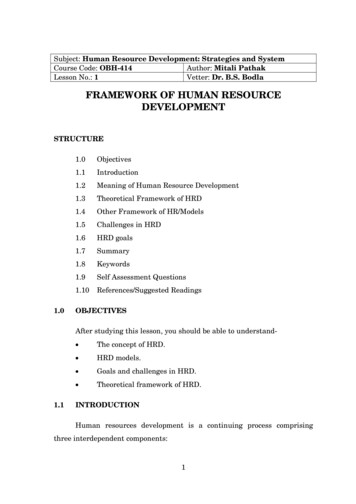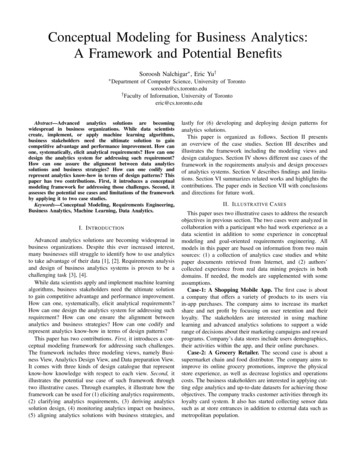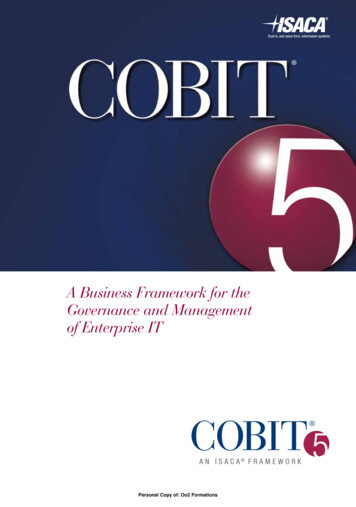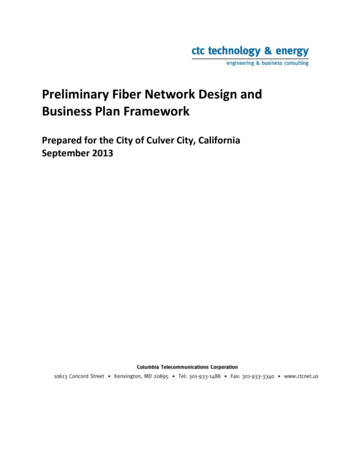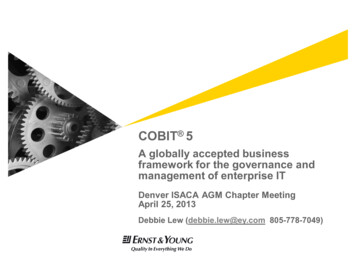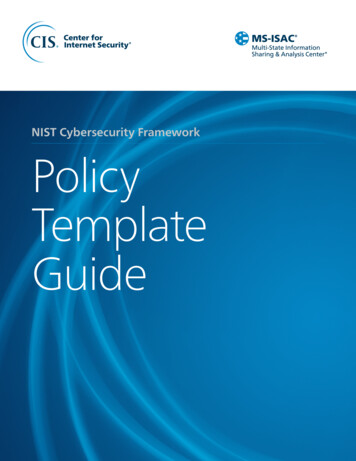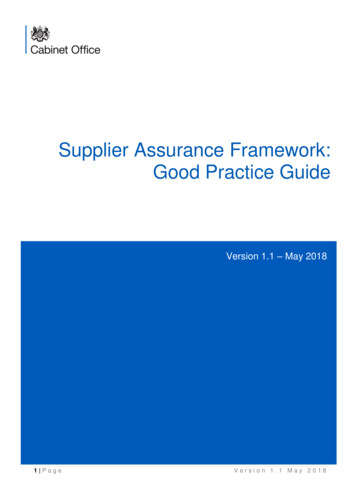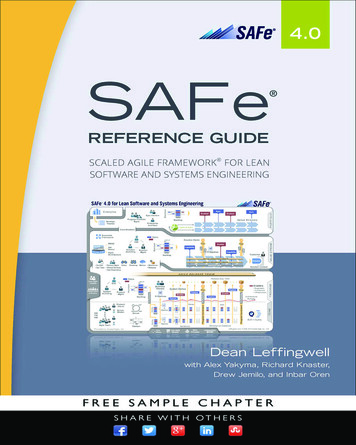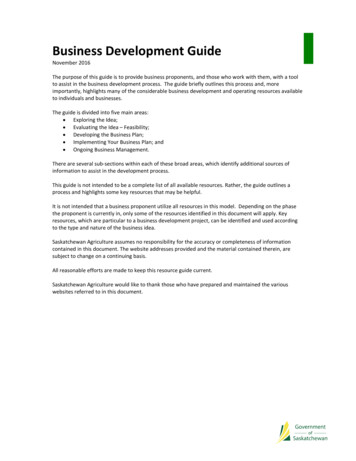
Transcription
Business Development GuideNovember 2016The purpose of this guide is to provide business proponents, and those who work with them, with a toolto assist in the business development process. The guide briefly outlines this process and, moreimportantly, highlights many of the considerable business development and operating resources availableto individuals and businesses.The guide is divided into five main areas: Exploring the Idea; Evaluating the Idea – Feasibility; Developing the Business Plan; Implementing Your Business Plan; and Ongoing Business Management.There are several sub-sections within each of these broad areas, which identify additional sources ofinformation to assist in the development process.This guide is not intended to be a complete list of all available resources. Rather, the guide outlines aprocess and highlights some key resources that may be helpful.It is not intended that a business proponent utilize all resources in this model. Depending on the phasethe proponent is currently in, only some of the resources identified in this document will apply. Keyresources, which are particular to a business development project, can be identified and used accordingto the type and nature of the business idea.Saskatchewan Agriculture assumes no responsibility for the accuracy or completeness of informationcontained in this document. The website addresses provided and the material contained therein, aresubject to change on a continuing basis.All reasonable efforts are made to keep this resource guide current.Saskatchewan Agriculture would like to thank those who have prepared and maintained the variouswebsites referred to in this document.
Phase 1:Exploring theIdeaDecisionPointPhase 2:Evaluating theIdeaDecisionPointPhase 3:Developingthe BusinessPlanDecisionPointPhase 4:Implementingthe BusinessPlanDecisionPointPhase 5:OngoingBusinessManagementOngoing
TABLE OF CONTENTSPhase 1 - Exploring the Idea – Pre-Feasibility1.1 Are You Ready? - Points to Consider When Starting Your Own Business Checklist for Going Into Business Getting Started in Small Business Starting and Growing a Business: Entrepreneurial Spirit Points to Consider When Starting a Business What is Entrepreneurship?1.2 Evaluating the Opportunity - Pre-Feasibility Guide to Market Research and Analysis Profitability – Will it Make Money?1.3 General Resources Business Start-Up Assistant Small Business Administration's Checklist for Going Into BusinessPhase 2 - Evaluating the Idea – Feasibility2.1 Assessing the Market Opportunity Preparing for Value-Added Business Initiatives Is My New Venture Idea Profitable? Feasibility Checklist for Starting a Small Business2.2 Business Structures and Board Governance Choosing the Right Structure for Your Agri–Business Establishing a Business in Saskatchewan Forming a Corporation Under The Business Corporations Act Choosing a Business Name2.3 Understanding Financial Institutions ABCs of Borrowing Demystify Your Banker Sources of Financing 18 Ways to Raise Capital for Your Business2.4 Understanding Industry Regulations Establishing a Business in Saskatchewan Canadian Copyright Information (Act, Regulations and Registration Information) Canadian Trademarks Information Canadian Patent Office Information U.S. Patent and Trademarks Office Financial and Consumer Affairs Authority – Securities Information2.5 Preliminary Site Selection and Key Production Inputs Selecting a Store Location for Your Business Guidelines for Livestock Development2.6 Identify Partners Selecting Professional Resources
2.7 Getting Professional Advice Guidelines for Selecting a ConsultantPhase 3 – Developing the Business Plan3.1 Developing Business Objectives Preparing a Business Plan3.2 Industry and Market Analysis Starting and Growing a Business3.3 The Marketing Plan Guide to Market Research and Analysis Marketing Plan – Outline3.4 The Operations Plan (Production) Writing an Operations Plan Venture Checklist3.5 The Management and Human Resources Plan Top Management and Key Personnel Positions in a Value-Added Business Employment and Social Development Canada – Resources and Labour Market Information3.6 The Financial Plan Looking at Cash Flow Agricultural Business Analyzer – Downloadable Spreadsheet3.7 The Environmental Plan Saskatchewan Environmental Farm Plans Lending and the Environment3.8 The Risk Management and Contingency Plan Risk Management ModulesPhase 4 - Implementing Your Business Plan4.1 General Resources Saskatchewan Community FuturesPhase 5 – On Going Business Management5.1 Strategic Planning Strategic Planning (in non-profit or for-profit organizations) Strategic Business Planning for Commercial Producers5.2 Marketing Management International Business Tools How Do I Initially Assess the Opportunity for a New Product or Service Idea? The Essentials of Pricing5.3 Operations Management Food Safety Enhancement Program An Abridged Guide to Lean Manufacturing5.4 Financial Management
The Canadian Entrepreneurs Guide to Securing Risk CapitalBasic BookkeepingFederal/Provincial Taxation GuideFinancial Ratio Analysis CalculatorsFinancial Performance DataCredit and CollectionsPreventing Theft and Fraud5.5 Human Resource Management Labour Laws at a Glance Managing People Hiring Checklist for Developing a Training Program Measuring Sales Force Performance5.6 Other Issues Expanding Your Business – Critical Assessment Factors for New Products Expansion Strategies5.7 General ResourcesOperations: Business Owner's Idea Café – Resources for Businesses Identifying and Selecting SuppliersMarketing: Annual Survey of Manufacturers
THE BUSINESS DEVELOPMENT GUIDEPhase 1 - Exploring the Idea – Pre-FeasibilityIntroduction:All business ventures start with an idea. When you have an idea that you believe could be the basis for agood business, there are several things you will want to consider and explore before proceeding. Thesewill include not only doing a quick assessment on the merits of the business idea, but also whetheroperating a business is something you really want to do. This important first stage is critical and will laythe foundation of the business development process that will follow.Taking an idea and developing a business around it takes considerable resources and time. This first stepis important as it determines whether you are prepared for the journey ahead. This first step will alsoassist in deciding whether the idea truly has potential and what will be required to make it successful.The failure rate of new business is high. Completing a pre-feasibility assessment is the first step indetermining whether you should proceed with your business idea. It can save you considerable time andmoney.1.1Are You Ready? – Points to Consider When Starting Your Own BusinessGoing into business is a major decision which will not only affect your working life but all aspects of yourlife. Considerable commitment is required, not only professionally, but personally and financially. It isessential to fully understand what will be required and whether the commitment required is desirable atthis time.Checklist for Going into Business Here are some questions and worksheets to help you think through what you need to know anddo. Canadian Business Service Centre g Started in Small Business You will find essential business start-up information from the perspective of Canadian banks. Canadian Bankers Association –www.cba.ca/index.php?option com content&view category&id 45&Itemid 55&lang enStarting and Growing a Business: Entrepreneurial Spirit Business success or failure depends on you. Evaluate yourself critically to see if you have what ittakes to be a successful entrepreneur. This page is a compilation of resources which includeslinks to a variety of sites. Government of Alberta - www1.agric.gov.ab.ca/ department/deptdocs.nsf/all/bdv11347Points to Consider When Starting a Business Typically, you will begin by analyzing yourself as a future entrepreneur. What kind of person areyou? What technical or special knowledge do you have? Self-confidence and drive, innovativethinking, goal-orientation, and business and technical knowledge are necessary to succeed. Canadian Business Service Centre - www.canadabusiness.ca/eng/125/106/
What is Entrepreneurship? We usually think of an entrepreneur as someone who is highly responsive to change, who seesopportunities that others may not see, and who mobilizes resources to make new thingshappen. Although some people feel that entrepreneurs are born, not made, experience hasshown us that entrepreneurship can be taught. Western Economic Diversification Canada - wd.gc.ca/eng/100.asp1.2Evaluating the Opportunity – Pre-FeasibilityA pre-feasibility study is a “quick” review of the industry you are entering. In this process you will do aquick assessment of the technology required, market opportunities, competition, materials/inputs andresources required, financing and assessment of the strengths and weaknesses of the project. Thisprocess can take three days to three weeks to complete.Information for completing the pre-feasibility study can be obtained from many sources, such as industryexperts, individuals from similar businesses, and the Internet.When evaluating a new business idea or product, it is essential that it be done thoroughly. It is moreeffective and less costly to identify challenges with the product or idea up front rather than months anddollars later.Guide to Market Research and Analysis This document is intended to help business owners better understand market research and itsimportance. It provides information on how to conduct a market research project, specifyingseveral options that are available to businesses regardless of their market research budget.Canadian Business Service Centre - www.canadabusiness.ca/eng/guide/2428/Profitability - Will it Make Money? This factsheet introduces farm management tools to help you answer specific questions aboutthe profitability of a proposed business. The income statement and sensitivity analysis help youanswer the question: Will establishing this new enterprise make money? Government of Alberta - www1.agric.gov.ab.ca/ department/deptdocs.nsf/all/agdex1140Decision Point – This is one of the points where you should stop and determine whether to proceedwith the business idea or not. If you decide to proceed, you will have identified some of the key issuesto be explored further in the business development process.1.3General Resources:Business Start-Up Assistant Welcome to the Business Start-up Assistant, where you will find essential business start-upinformation from the federal and provincial governments, as well as many other sources. Canadian Business Service Centre – www.canadabusiness.ca/eng/page/2856/sgc-47/Small Business Administration's Checklist for Going Into Business The Checklist for Going into Business is a guide to help you prepare a comprehensive businessplan and determine if your idea is feasible, to identify questions and problems you will face inconverting your idea into reality and to prepare for starting your business. United States Small Business Administration www.sba.gov/smallbusinessplanner/plan/index.html
Phase 2 – Evaluating the Idea - FeasibilityIntroduction:The key step in evaluating the business idea is the completion of a feasibility study. The feasibility studyprovides a more detailed and specific investigation of the business idea than was completed in the prefeasibility analysis.A feasibility study involves gathering, analyzing and evaluating information with the purpose of answeringthe question: “Should I go into this business?”This study will demonstrate how the business would operate and under what assumptions. It will identifythe critical resources required for the success of the project.The feasibility study will determine whether you should proceed with the business idea or not, andidentify the key issues in proceeding. As in the case of the pre-feasibility phase, the feasibility study cansave considerable time and money in the long run. It is far better to determine through a feasibility studythat the business idea cannot proceed, before considerable resources are invested in the business plan.2.1Assessing the Market OpportunityThe first step in evaluating the idea is to determine what products or services the business will offer.Below are some of the key questions that need to be answered as part of assessing the opportunity oridea. Answering these questions will tell you why you are proceeding. Who will the customer be?Why will the customer buy this product over other competing products?What will it take to enter and participate in the market place?Preparing for Value-Added Business Initiatives This site goes through the specific process of examining a new market/business idea. Agricultural Marketing Resource Centre - www.agmrc.org/markets industries/Is My New Venture Idea Profitable? As an entrepreneur exploring the potential of a new venture, you must answer the followingquestion, "Can my new venture idea make money?" A feasibility study will help you in answeringthis question, as well as assist you in transforming your new venture idea into a successfulbusiness. Government of Alberta –www1.agric.gov.ab.ca/ asibility Checklist for Starting a Small Business This publication is a checklist for the owner-manager of a small business enterprise or for onecontemplating going into business for the first time. The questions concentrate on areas youmust seriously consider to determine if your idea represents a real business opportunity, and ifyou really know what you are getting into. You can use the checklist to evaluate a completelynew-venture proposal or an apparent opportunity in your existing business. Canadian Business Service Centre - www.canadabusiness.ca/eng/125/106/
2.2Business Structures and Board GovernanceThe type of business structure selected will influence ownership and capital requirements. There are anumber of business structures to choose from, and these are listed as follows: sole proprietorship; partnership; limited partnership; corporation; co-operative; and new generation co-operative.Whether an entity is incorporated as a company, a new generation co-operative, or a co-operative, it willhave articles of incorporation and bylaws. These are the rules that govern how a board of directors runsthe company. The principles and rules for board governance are set out for companies in Saskatchewan’slegislation entitled The Business Corporations Act. A training session on board governance is advised, andshould include information on the following: directors' responsibilities in company management;directors' liability in acting as a director; andmanagement responsibilities to the company.Choosing the Right Structure for Your Agri-Business This document describes the various business structures and their implications on the business. Government of Saskatchewan - publications.gov.sk.ca/details.cfm?p 76487Establishing a Business in Saskatchewan In order to do business in Saskatchewan, a business must be registered with the Corporate Registry, Information Services Corporation.Government of Saskatchewan – blishing%20a%20Business%202016.pdfForming a Corporation Under The Business Corporations Act This site reviews issues around forming a corporation under The Business Corporations Act Government of Saskatchewan, Ministry of Justice and Attorney General ages/default.aspxChoosing a Business Name This page provides information and resources for naming your business, registering a trademark,and searching for existing business names and trademarks. Canadian Business Service Centre – rstanding Financial InstitutionsFinancing is a critical aspect of all businesses, and it is important to understand the requirements, types,and sources of financing.ABCs of Borrowing This document contains general information on lending and the information and questions thatbanks typically request. United States Small Business Administration - managing-business/starting-business
Demystify Your Banker This is a guide for entrepreneurs seeking a loan from their bank. The guide discusses what yourloan proposal should contain; what your banker looks for; common bank terms; and tips toincrease your chances of success. Business Development Bank of Canada www.bdc.ca/EN/advice centre/articles/Pages/demystify your banker.aspxSources of Financing This site provides an extensive directory of Government grants, loans and financing. Government of Canada - www.canadabusiness.ca/eng/18 Ways to Raise Capital for Your Business Mini-guides that cover the basic information on 18 different financing sources are found on thissite. Entrepreneur.com – 4Understanding Industry RegulationsPermits, licenses and agreements are part of the feasibility study as well and must be investigated toensure the project can comply with these requirements. The following groups and agencies should becontacted to determine their requirements: Saskatchewan Agriculture Rural municipalities Saskatchewan Highways and Infrastructure SaskPower SaskEnergy Incorporated Saskatchewan Health Saskatchewan Watershed Authority Saskatchewan EnvironmentEstablishing a Business in Saskatchewan In order to do business in Saskatchewan, a business must be registered with the CorporateRegistry, Information Services Corporation. Government of Saskatchewan - ian Copyright Information (Act, Regulations and Registration Information) This page provides information on Canadian copyright information and regulations. Nova Scotia Community College - subjectguides.nscc.ca/copyrightCanadian Trademarks Information This page provides information on Canadian trademarks information and regulations. Canadian Intellectual Property Office strategis.ic.gc.ca/sc mrksv/cipo/tm/tm main-e.htmlCanadian Patent Office Information This page provides information on Canadian patent information and regulations. Canadian Intellectual Property Office - strategis.ic.gc.ca/sc mrksv/cipo/patents/pt main-e.htmlU.S. Patent and Trademarks Office This page provides information on U.S. patent information and regulations. United States Patent and Trademarks Office - www.uspto.gov/index.html
Financial and Consumer Affairs Authority – Securities Information This section has information for persons and companies who have to comply with Saskatchewansecurities laws. Government of Saskatchewan - Financial Services Commission s2.5Preliminary Site Selection and Key Production InputsOne of the most significant decisions that will be made is the location of the business operations. Theselection of a location must take into account various issues, such as access to the market place; inputs,utilities, workforce, regulations, and transportation infrastructure. Some of the areas that need to beconsidered in the analysis are:Selecting a Store Location for Your Business The choice of a store location has a profound effect on the entire business life of a retailoperation. A bad choice may all but guarantee failure; a good choice, success. Canadian Business Service Centre - www.canadabusiness.ca/eng/125/143/Guidelines for Livestock Development These are guidelines from a livestock development publication, including information onchoosing a site location. Government of Saskatchewan - Ministry of Agriculture x?DocID 11439,14484,14483,81,1,Documents&MediaID 6253&Filename Guidelines for Livestock Development.pdf2.6Identify PartnersNo individual has all the skills necessary to create and manage a new business. Proponents mustunderstand their own limitations and seek out help to offset their weaknesses. Business partners oremployees should be hired to cover any deficiencies of the proponent. Review Phase 1, section 1.1 toidentify your individual weaknesses.Partners may include other proponents, investors, suppliers, customers, consultants and lenders. You willalso be required to seek advice from professionals, such as accountants, lawyers, engineers andagrologists. Depending on the business venture, you will need your partners' expertise at different stagesof planning. In general, seek expertise from your partners early in planning to ensure your businessassumptions are correct.Selecting Professional Resources This document reviews the four main areas of professional services with which you may need toconsult: accountant, lawyer, banker, and insurance broker. Canadian Business Service Centre - www.canadabusiness.ca/eng/87/921/2.7Getting Professional AdviceSelecting professional advisors for the company is essential. Therefore, it is important to take the time toget background and references on potential advisors. To get the most from corporate advisors, it isimperative they be knowledgeable about the industry your business is in, and credible in their field ofexpertise.Guidelines for Selecting a Consultant
This site outlines guidelines and criteria for choosing a consultant.Government of Ontario – mDecision Point - This is one of the points where you should stop and determine whether or not toproceed with the business idea. If you decide to proceed, you will have identified some of the keyissues to be explored further in the business development process.
Phase 3 – Developing the Business PlanIntroduction:A business plan is a key tool which is developed to assist the individual/group in achieving its goals andobjectives. It is the detailed plan for proceeding with the business and is used to communicate thebusiness's objectives to internal and external stakeholders. The proponents of the business will bemeasured based on the information and milestones detailed in the business plan. The plan will be used toseek both investment and debt capital. A business plan is the enterprise's presentation to the world andwill be judged on how complete, organized and well-written it is.The enterprise, with very few exceptions, should seek the services of a consultant who understands theindustry and has had experience in developing business plans. The enterprise should be diligent inverifying the credentials and abilities of various consultants, as it is essential to have a well-written, soundplan. A good consultant will involve you in the process of writing the business plan to ensure the planmeets your needs and is fully understood. The business plan is a tool you will use to sell your idea.3.1Developing Business ObjectivesThis is typically where development of short-term and long-term objectives occurs, which will be used togive the business enterprise direction and to measure the success of the operation.Preparing a Business Plan This page provides information and resources on the basics of business planning for starting abusiness in Saskatchewan, including guides and tools to help you develop a detailed businessplan. Canadian Business Service Centre – www.canadabusiness.ca/eng/page/2865/3.2Industry and Market AnalysisAn industry and market analysis of the environment in which the enterprise will compete is essential tounderstanding the business opportunities.Starting and Growing a Business This site provides information sources that can assist you in putting an effective business plantogether, including examples of completed plans. Government of Alberta - www1.agric.gov.ab.ca/ department/deptdocs.nsf/all/bdv113473.3The Marketing PlanA plan is necessary to create an outline of all aspects of the marketing mix, including product, pricing,distribution and promotion.Guide to Market Research and Analysis Acquiring accurate and specific information about your customers and competitors is a criticalfirst step in market investigation and development of a marketing plan. Canadian Business Service Centre - www.canadabusiness.ca/eng/guide/2428/
Marketing Plan - Outline A marketing plan is designed to direct company activities towards the satisfaction of customerneeds, determine what the customer wants, develop a product/service to meet those needs, getthe product/service to the end-user and communicate with the customer - at a profit. Canadian Business Service Centre – www.canadabusiness.ca/eng/guide/2533/3.4The Operations Plan (Production)An operations plan sets out production targets, capacity and costs associated with each step of theproduction process. It will discuss how inputs will be secured and how the functions of scheduling,planning, purchasing and operations control will be maintained. The management information systemsthat will be used to generate information for management to make decisions will be discussed.Writing an Operations Plan In the operations section and financial statements section that follows, the scope of the businessplan changes from the strategic to the operational. This change makes it more difficult to specifyexactly what needs to be included in the operations section (or "operations plan") because manyof the operational details depend on the nature of the business itself. Menu Inc. - nal-plan-for-your-smallbusiness.htmlVenture Checklist The checklists located on the website below are meant to assist you in assessing each pointagainst your business plan. Canadian Business Service Centre - www.canadabusiness.ca/eng/125/144/3.5The Management and Human Resources PlanThis plan describes the management team, highlighting its marketing, technical, operational and financialskills and experience. A strong management team is essential for operating a successful business.Investors and debt providers view this as a key element in their assessment of risk of the operation. Ahuman resources plan will provide a detailed list of staffing needs and an outline of training plans, costsand employee benefits.Top Management and Key Personnel Positions in a Value-Added Business This site reviews the top management and personnel issues for a value-added business and givesa description of the role each should play. Iowa State University - 1.pdfEmployment and Social Development Canada - Resources and Labour Market Information This page provides information on region specific services for individuals, such as careerplanning, financial benefits, jobs, labour market information, information on wages and salaries,who hires, and where to get training, etc. Employment and Social Development Canada - www.esdc.gc.ca/eng/home.shtml3.6The Financial PlanA financial plan demonstrates the financial potential of the business venture and its capital requirements,including detailed descriptions of the assumptions used to develop the financial projections. A financialplan is a valuable tool for the enterprise and is a crucial element in the investors' evaluation of theproposal.
Looking at cash flow This factsheet shows you how to analyze the financial side of your new enterprise. In order toanalyze the new enterprise, you need to answer the following questions: When do your expensesoccur? When do you expect revenue? Will you need extra funds to cover operating expenses orcapital purchases? Government of Alberta www1.agric.gov.ab.ca/ Agricultural Business Analyzer - Downloadable Spreadsheet The Agricultural Business Analyzer (ABA) is a financial analysis tool designed to help users reviewup to five years of historical financial data and prepare and analyze a financial plan for theupcoming year. The template is an Excel spreadsheet made up of 25 sheets in the overallworkbook. The individual sheets are identified by tabs at the bottom of the window and can beaccessed by clicking on them. Government of Alberta www1.agric.gov.ab.ca/ Department/softdown.nsf/main?openform&type ABA&page information3.7The Environmental PlanA description of how the enterprise will address the regulatory requirements and community concernsabout the project.Saskatchewan Environmental Farm Plans This site provides information regarding what environmental farm plans are, who can participatein the program, and why they are valuable. This site also links to upcoming Environmental FarmPlan events and seminars. Government of Saskatchewan - mental-farm-plansLending and the Environment This site reviews the position of the banking industry on the environment. As businesses, banksare not only obliged to meet legal and regulatory requirements; they also need to ensure theirpolicies and practices are environmentally responsible. Canadian Bankers Association www.cba.ca/index.php?option com content&view category&id 62&Itemid 54&lang en3.8The Risk Management and Contingency PlanThis area includes an outline of the potential problems relating to the project and the steps that are beingtaken to mitigate these risks.Risk Management Modules These four modules on the topic of risk management are a part of Dr. Len Bauer’s careerspanning series entitled "Managing the Modern Farm Business”. Government of Alberta - www1.agric.gov.ab.ca/ department/deptdocs.nsf/all/bmi10085
Phase 4 - Implementing Your Business PlanAn implementation plan lays out the timing of events, along with an estimate of expenditures at each stepin the
Business Development Guide . November 2016 . The purpose of this guide is to provide business proponents, and those who work with them, with a tool to assist in the business development process. The guide briefly outlines this process and, more importantly, highlights many of the considerable busine

